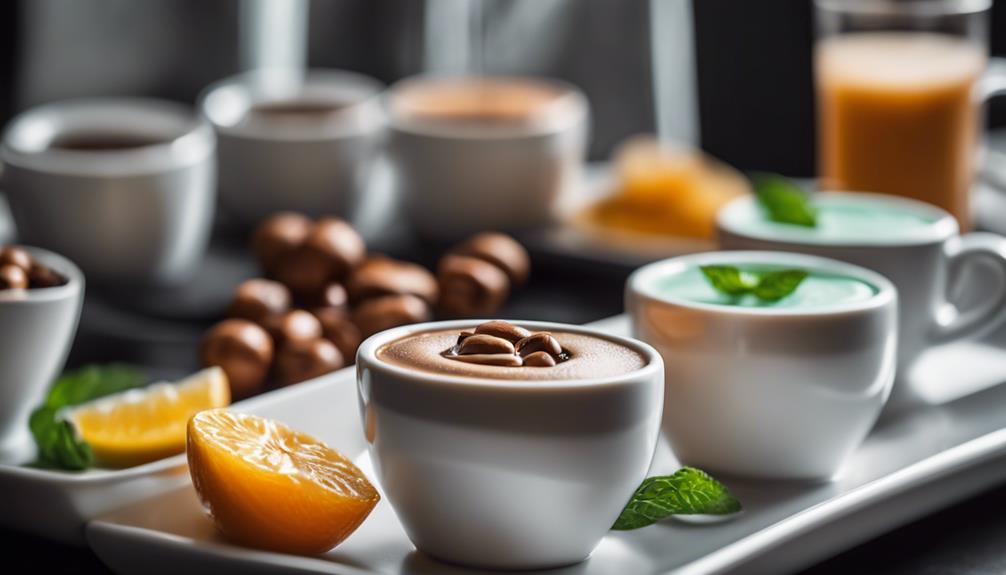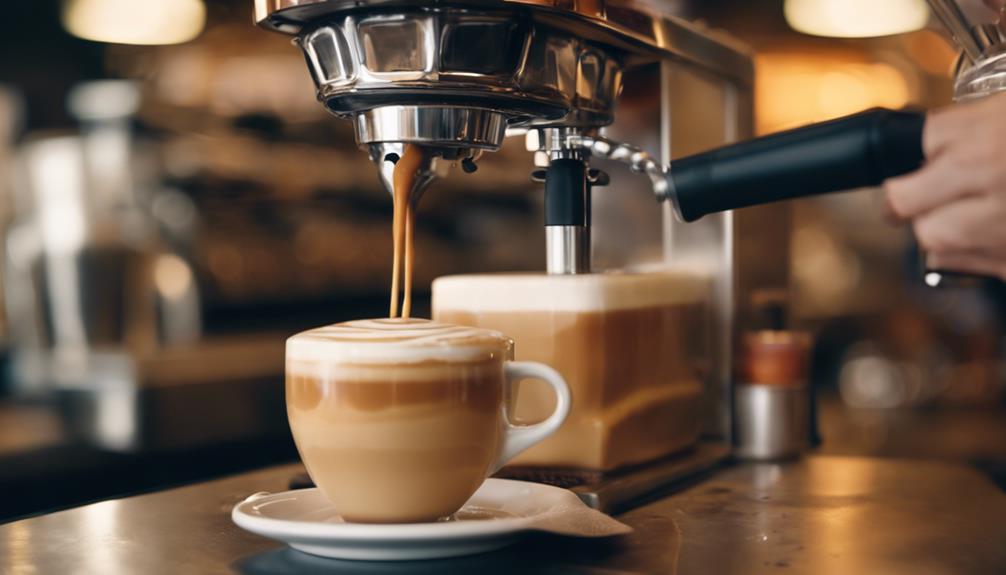You are on the brink of discovering an invigorating twist on traditional espresso: a shaken espresso, a trendy beverage that combines the boldness of freshly brewed espresso, the coolness of ice, and the creaminess of milk, all mixed together with a unique frothy texture. This drink, originating from Italy, is ideal for hot summer days, and its modern variations offer countless flavor combinations. By shaking espresso with ice and sweeteners, you will create microbubbles that enhance the texture and taste. Now, prepare to elevate your coffee experience to the next level, and master the art of crafting the perfect shaken espresso to suit your preferences.
Key Takeaways
- A shaken espresso is a refreshing iced coffee drink originating from Italy, derived from the shakerato, and designed for hot Mediterranean summers.
- It's made by shaking freshly brewed espresso, ice, and sugar/simple syrup to create a frothy, aerated texture and a cool, rich flavor profile.
- Quality ingredients like purified ice, real milk, and high-quality espresso machines elevate the flavor and texture of the drink.
- Shaken espresso can be customized with flavorings like vanilla or brown sugar syrup and milk alternatives like oat or almond milk for a creamy hybrid.
Origins of the Shaken Espresso
Delving into the roots of this trendy coffee drink, you'll discover that the shaken espresso originates from Italy, where the shakerato was born as a revitalizing solution to the sweltering Mediterranean summers. This Italian classic was created to provide a rejuvenating iced coffee option to combat the heat. The traditional shakerato recipe consists of freshly brewed espresso, ice, and sugar or simple syrup, served in a chilled glass to enhance its crisp presentation.
As you explore the history of the shaken espresso, you'll find that it's directly derived from this Italian drink. The name 'shaken' emphasizes the unique preparation method, which involves shaking the ingredients to create a frothy and aerated texture. This innovative technique has led to the evolution of the shaken espresso, with modern variations incorporating milk to create a creamy hybrid.
Despite its transformations, the shaken espresso remains true to its Italian roots, paying homage to the shakerato's rejuvenating legacy.
A Refreshing Coffee Experience
As you explore the world of shaken espresso, you'll discover a revitalizing coffee experience that's uniquely yours.
By combining ice and espresso, you'll unveil a flavor profile that's both cool and rich, perfect for warm weather.
Now, let's take a closer look at how ice and espresso unite to create this innovative drink.
Ice and Espresso Unite
When you combine freshly brewed espresso with ice, the result is a revitalizing coffee experience that's perfect for warm weather, and the best part is, it's incredibly easy to make.
You'll be enjoying a shaken espresso, a trendy drink inspired by the Italian shakerato. To create this invigorating treat, you'll need to shake espresso shots with ice for about 45 seconds, which creates microbubbles that enhance the drink's texture and lightness.
The quality of your ingredients matters, so be sure to use purified ice and real milk to achieve the best flavor and creamy consistency.
What you'll get is a stronger coffee flavor than traditional iced lattes, thanks to the lower milk content and multiple espresso shots. Plus, you can customize your shaken espresso with flavorings like vanilla or brown sugar syrup to make it your own.
With its frothy texture and invigorating taste, this drink is sure to become your new go-to for warm weather.
Coffee's Icy Evolution
By embracing the fusion of espresso and ice, you'll discover a revitalizing coffee experience that's perfect for warm weather, one that's been refined over time through the evolution of cold coffee preparation.
As you explore the world of iced coffee, you'll find that shaken espresso takes center stage, offering a unique twist on traditional espresso. This modern evolution of cold coffee preparation combines espresso, ice, and sweeteners, creating a revitalizing drink that's perfect for hot summer days.
The shaking process introduces microbubbles, resulting in a frothy texture that enhances the overall coffee experience while cooling the beverage quickly.
You can customize your shaken espresso by adding milk or dairy alternatives, which add creaminess and help balance the espresso's bitterness.
As a trendy and innovative drink, shaken espresso has gained popularity in cafes and homes, catering to diverse consumer preferences for invigorating caffeine options. With its strong and bold flavor, shaken espresso offers a unique twist on traditional espresso drinks. This method of preparation enhances the rich and complex flavors of the coffee, making it a favorite among coffee connoisseurs. Understanding the espresso coffee differences can help coffee enthusiasts appreciate the various nuances and profiles of this beloved beverage.
Essential Ingredients and Equipment

You'll need a few key ingredients and tools to craft a shaken espresso that's both rich and invigorating. To get started, you'll require freshly brewed espresso, ice, and a sweetener of your choice. Optional add-ins like milk or flavorings can enhance the flavor profile and creaminess of your shaken espresso.
Here's a breakdown of the essential ingredients and equipment you'll need:
| Ingredients | Equipment | Notes |
|---|---|---|
| Freshly brewed espresso | Espresso machine | Use a quality machine for smooth, rich shots |
| Ice | Cocktail shaker | Purified water ice is best for ideal flavor |
| Sweetener (optional) | Choose your preferred sweetener, e.g., sugar, honey, or syrup |
Using real milk can elevate the creaminess and balance of your shaken espresso, making it a revitalizing alternative to traditional iced coffees. A double-shot of espresso typically provides a bold flavor profile and a stronger caffeine kick. Remember to use a quality espresso machine that can consistently brew smooth and rich espresso shots for the best results.
Preparation Steps and Techniques
To craft a shaken espresso that's truly exceptional, start by cooling a freshly brewed double shot of espresso to room temperature. This allows the flavors to meld together and the espresso to chill slightly before shaking.
Next, fill a cocktail shaker with ice, then add the chilled espresso along with any desired sweeteners or flavorings, such as vanilla syrup or brown sugar. Seal the shaker tightly and shake vigorously for about 15 to 30 seconds to achieve maximum aeration and chilling of the beverage. This step is essential in creating a smooth and creamy texture in your shaken espresso.
After shaking, pour the mixture over fresh ice in a glass. If desired, add a splash of milk or a dairy alternative for an even creamier texture.
Don't be afraid to experiment with different shaking techniques and ice types, such as using larger ice cubes combined with smaller ones, to optimize the texture and flavor of your shaken espresso.
Modern Variations and Flavor Options

As you explore the world of shaken espresso, you'll discover a range of modern variations that cater to your unique tastes. One such variation is the iced apple crisp oatmilk shaken espresso, which combines the rich, bold flavors of espresso with the refreshing crispness of apples and the creamy texture of oatmilk. Whether you prefer a classic espresso with a hint of sweetness or an adventurous mix of flavors, there’s a shaken espresso out there waiting to delight your palate. So go ahead and explore the world of shaken espresso to find the perfect blend for you.
You can experiment with flavorful milk options, like oat or almond, to create distinct textures and flavors.
From invigorating summer twists to rich and decadent treats, the possibilities are endless, and it's time to shake things up!
Flavorful Milk Options
Customizing your shaken espresso with various milk options opens up a world of flavors and textures, from the richness of whole milk to the subtle nuttiness of almond milk.
When you add milk to your espresso, you're not only enhancing the creaminess but also softening the bitterness, making it a more invigorating drink.
If you're looking for plant-based options, oat and almond milk are popular choices that won't sacrifice taste or texture.
You can also experiment with flavored syrups like vanilla or caramel to create a delightful balance of sweetness and creaminess.
The key to achieving the best flavor and texture is using high-quality milk or dairy alternatives. Freshness greatly impacts the overall experience, so don't settle for anything less.
By combining your favorite milk option with a shot of espresso, you'll reveal a world of flavors and textures that will elevate your coffee game.
Whether you're a dairy lover or a plant-based enthusiast, the possibilities are endless, and the perfect cup of shaken espresso is just a milk option away.
Shaken Espresso Textures
You'll find that the unique texture of shaken espresso, with its frothy microbubbles, offers a rejuvenating twist on traditional coffee drinks, making it a perfect canvas for modern variations and flavor options. As you explore the world of shaken espresso, you'll discover a range of textures and flavors to tantalize your taste buds.
| Variation | Description |
|---|---|
| Oat Milk Shaken Espresso | Creamy and velvety, with a subtle nutty flavor |
| Almond Milk Shaken Espresso | Light and invigorating, with a hint of sweetness |
| Vanilla Syrup Shaken Espresso | Sweet and indulgent, with a rich creamy flavor |
| Brown Sugar Syrup Shaken Espresso | Deep and caramel-like, with a smooth mouthfeel |
When creating your perfect shaken espresso, remember that high-quality ingredients are key. Fresh milk and purified ice will elevate the drink's texture and flavor, allowing you to fully appreciate the nuances of this trendy coffee drink. Whether you're a coffee connoisseur or just looking to mix things up, shaken espresso's unique texture and flavor options make it a must-try.
Refreshing Summer Twists
Take your shaken espresso to the next level this summer by infusing it with invigorating twists that will quench your thirst and tantalize your taste buds.
You can customize your shaken espresso with various flavorings like vanilla, caramel, or seasonal syrups to enhance its rejuvenating qualities.
Want a creamier coffee drink? Try adding different milk alternatives like oat or almond milk, which introduce unique flavors that complement the espresso.
For a fruity twist, add a splash of flavored syrups or fresh fruit purees to create a vibrant and revitalizing summer beverage.
If you prefer a smoother, less acidic taste, experiment with cold brew coffee instead of traditional espresso.
Finally, top your shaken espresso with a sprinkle of cocoa powder or a dash of cinnamon to add an extra layer of flavor while maintaining its invigorating essence.
With these modern variations and flavor options, you can create a shaken espresso that's perfect for hot summer days.
The Importance of Quality Espresso
What sets a shaken espresso apart from its mediocre counterparts is the quality of the espresso that serves as its foundation. When you're crafting a shaken espresso, you need a rich, bold espresso shot to build upon. Anything less, and you'll be left with a drink that's lacking in flavor and depth.
To get that perfect espresso shot, you'll need to start with freshly roasted coffee beans, ground just before brewing to maximize flavor extraction. Then, use a high-quality espresso machine to guarantee consistent pressure and temperature – this is essential for producing a rich and bold espresso.
Aim for an extraction time of around 25 to 30 seconds, as this allows for ideal flavor balance without over-extraction bitterness. Finally, consume your espresso shortly after brewing to preserve its aromatic compounds and prevent flavor degradation.
Shaken Vs Stirred: a Taste Test

Now that you've crafted the perfect espresso shot, it's time to put it to the test: shaken versus stirred, which method reigns supreme regarding flavor and texture?
To find out, let's conduct a taste test. When you shake your espresso, you'll notice a smoother and more balanced flavor profile compared to stirring. This is due to the aeration that occurs during shaking, which integrates the ingredients better.
The shaken espresso boasts a desirable frothy texture created by microbubbles, while stirred espresso tends to have a harsher taste with less integration. You'll find that the shaken version is more invigorating and easier to drink, with a lighter and creamier flavor.
In contrast, stirred espresso can be more concentrated and bitter. Taste testers often favor shaken espresso for its pleasant flavor profile. Plus, making shaken espresso at home can be more cost-effective than buying it at a coffee shop.
The Science of Froth and Texture
As you shake your espresso with ice, microbubbles of air are introduced, which contribute to a lighter, frothier texture that enhances the overall drinking experience. This aeration process helps create a desirable frothy layer on top of the shaken espresso, distinguishing it from other coffee preparations.
When you use a shaker with ice, the agitation and temperature changes facilitate quick chilling and slight dilution, allowing the flavors to meld while maintaining the espresso's boldness.
The emulsification of milk during the shaking process stabilizes the foam, prolonging the frothy texture and creating a creamier mouthfeel. The unique combination of agitation and temperature changes enhances the sensory experience, making shaken espresso both visually appealing and enjoyable to drink.
The result is a revitalizing, velvety-smooth beverage with a rich flavor profile. As you savor your shaken espresso, the frothy texture and bold flavors meld together, creating a truly unique and delightful coffee experience.
Customizing Your Shaken Espresso

You can take your shaken espresso to the next level by experimenting with various flavor combinations and ingredients to create a personalized drink that suits your taste preferences.
When customizing your shaken espresso, you have endless options to enhance the flavor profile. Try adding vanilla syrup, caramel, or seasonal spices to give your drink a unique twist.
If you prefer it sweet, adjust the amount of simple syrup or sugar to your taste – a typical recommendation is 1-2 teaspoons per serving.
You can also experiment with different milk alternatives, such as oat, almond, or coconut milk, to change the texture and flavor.
Add a dash of hazelnut or peppermint extract to create a signature drink that caters to your personal preferences and seasonal trends.
Finally, top your shaken espresso with a sprinkle of cocoa powder or cinnamon to elevate the presentation and add an aromatic finish to the beverage.
With these options, you can craft a shaken espresso that's truly one-of-a-kind.
Elevating Your Coffee Game
Take your coffee to new heights by mastering the art of shaken espresso, a game-changing drink that's redefining the way we experience coffee. By perfecting this trendy drink, you'll be able to impress friends and family with your barista skills. But what sets shaken espresso apart from other coffee drinks?
| Shaken Espresso Benefits | Why It Matters |
|---|---|
| Stronger flavor | More intense coffee experience |
| Frothy texture | Enhances overall drinking experience |
| Customizable | Allows for personalized flavor profiles |
| Quality ingredients | Balances bitterness and creaminess |
| Unique experience | Stands out from traditional coffee options |
One way to elevate your shaken espresso game is by experimenting with different flavorings, such as brown sugar syrup. This adds a rich, caramel-like flavor that complements the boldness of the espresso. By incorporating high-quality ingredients and unique flavor combinations, you'll be able to create a shaken espresso that's truly one-of-a-kind. So, don't be afraid to get creative and take your coffee to new heights!
Frequently Asked Questions
What Is a Shaken Espresso Drink?
You're wondering what a shaken espresso drink is? It's a revitalizing coffee treat that combines brewed espresso, ice, and sweeteners, shaken together for a frothy, chilled drink that's smooth and easy to sip on.
How Is a Shaken Espresso Different From a Latte?
"Wow, you're still wondering what's up with these two drinks? Alright, let's get real – a shaken espresso packs more espresso shots, less milk, and a frothy chill, whereas a latte's all about creamy sweetness, got it?"
Why Are Shaken Espressos so Good?
You'll love shaken espressos because they offer a unique combo of rich flavor, revitalizing temperature, and velvety texture, making every sip an exciting experience that's both energizing and satisfying.
What Is the Science Behind Shaken Espresso?
You're wondering what's behind the magic of shaken espresso? It's all about the science! When you shake espresso with ice, you're creating microbubbles, cooling and diluting the flavor, and stabilizing the foam for a rich, creamy experience.
Conclusion
Now that you've uncovered the secrets of the shaken espresso, it's time to put your skills to the test.
Will you dare to experiment with new flavors and techniques, or will you stick to the classic recipe?
The world of shaken espresso is yours to conquer, and the possibilities are endless.
But be warned: once you've experienced the velvety texture and intense flavor, there's no going back.
Your coffee game will never be the same again…









